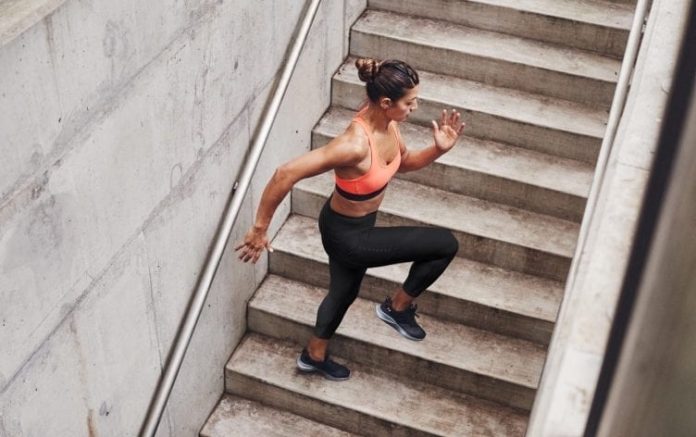
Getting into a regular walking routine is a great way to improve overall fitness and shed pounds. To keep it enjoyable and challenging, it’s a good idea to add variety to your workouts. One great way to do that: climbing stairs. Even if you don’t have stairs in your house, you can find a staircase at a park, local track or somewhere along your walking route.
THE BENEFITS OF STAIR WORKOUTS
Including stairs helps you challenge yourself and builds lower-body strength. “The mechanics required for walking and walking up stairs are different,” explains Pete McCall, a certified strength and conditioning specialist. “Stair workouts use more muscles in the legs, particularly the thigh and glute muscles. Walking up stairs requires the quadriceps and hamstrings to act concentrically, which are shortening actions. You’re also using the resistance of your own body weight to help make the legs stronger and burn more calories at the same time.”
Going down stairs can have a big benefit, too, and help you build strength to decrease fatigue as you increase the duration of your walks. “The quads and hamstrings are now forced to perform eccentric, or muscle-lengthening actions, to decelerate the body as it comes down the stairs.”
Building strength in the quadriceps, hamstrings and glutes not only helps build endurance for long walks, but it can also help you improve the efficiency of your stride and speed up your cadence while avoiding injury — all crucial elements to losing weight and improving your overall fitness as a walker.
WHAT TO KEEP IN MIND BEFORE GETTING STARTED
Like anything else, when you begin a new workout routine, you’ll need to be careful to avoid injury. It’s important to rest between sessions and avoid back-to-back strength-training days.
“Start slow,” McCall says. “It’s a different load for the muscles. Always start with walking up the stairs and progress the number of sets and/or speed when it feels good and soreness is minimal.”
McCall also recommends taking it easy going down and concentrating on making the up portion of your stair workouts more difficult. “For people used to walking, it’s coming down the stairs that’s often more challenging.” You can include stairs during your normal walks or do them as a separate workout depending on your current fitness level and goals.
STAIR WORKOUTS TO TRY
Try this sample workout from McCall and remember to work your way up gradually. If you need to skip the crossover steps at first that’s fine, just make sure to listen to your body.
- Warmup: Walk up the set of stairs 2–3 times at normal speed.
- Set: Walk briskly up and down the stairs using every step; repeat four more times. Once you’ve completed the fifth set, walk up the stairs skipping a step for five sets, then walk down normally for five sets.
- Finish: Complete three sets of crossover steps. From the side and moving to your left, cross the right leg in front of the left as you move up the stairs. Walk down and repeat in the opposite direction.
For supplemental strengthening on stairs that can be done at home, try these exercises:
- Forward walking up the stairs with a resistance band around the ankles (walk down without the band).
- Lateral walking up the stairs with a resistance band just above the outside of the knees to strengthen the abductors and glute medius (walk down without the band).
- Bulgarian split squats, with the back leg resting one or two stairs up as the front leg bends to 90 degrees. This helps build glute and quadriceps strength.
- Tricep dips two stairs up (or alternatively on a chair) to strengthen the shoulders and promote a better arm swing.
































